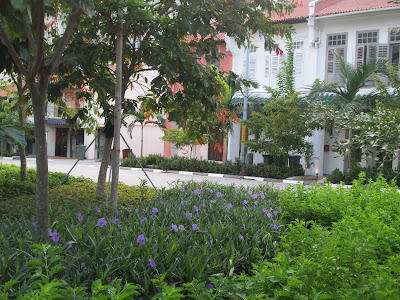Winter has arrived in Hawaii so it was time to harvest my Ginger a few weeks ago. I was pleasantly surprised with the results....so much Ginger in fact that I was able to share with my kids and a few Chinese cook friends. Just in time too, to make hot lemon Ginger tea that is so nice on cold winter evenings. I have attempted to grow Ginger in 10 gallon pots a few times in the past without much success. Now I am growing it in a 3 ft. wide, low tub with lots of compost which seems to work out much better. It is a learning process and I still have a few new tricks I want to try out this year.
 |
| Mature plants |
Ginger has been used for cooking and medicinal purposes for at least 4000 years in Asia and now used around the world. I suspect that the Dutch had a part in giving us powdered ginger for baking from their colonies and taking Ginger beyond its root form. Growing up I only knew Ginger as a spice powder to add to cookies and gingerbread. It took adulthood and living in different countries to make Ginger root part of my regular cooking. I tend to do most of my cooking on the stove top which means lots of stir fried vege and meat dishes. Minced garlic and Ginger root are always part of the deal. I keep most of my Ginger in the freezer and just chop or grate what I need off the frozen root piece. Ginger root will also last fresh in the fridge for about a month if kept in a paper bag. Ginger root sells at my local supermarket for $5 a pound, ($3 in Chinatown), so it gives me some satisfaction to grow my own.
 |
| Young ginger rhizomes growing |
To grow Ginger you just replant some of the harvested root....actually it is technically a rhizome and the real roots grow off it. You can break it into small pieces of just a few inches if you like as long as there are a few "eyes" or nodes on it which are the points of new growth. However, the bigger the piece of Ginger you plant, the bigger the Ginger "hands" that you will harvest. It takes 8-10 months for the Ginger rhizomes to be really big enough for a good harvest. If you are going to replant some of your harvested rhizome, give it a few days first to dry out and make protective scars where it has been broken or cut to prevent it rotting in the soil. You can also have gardening fun with a piece of Ginger root from the supermarket which will grow just the same. Look for a nice plump hand of Ginger and then soak it in water for a day first to get it hydrated and to remove any growth inhibiter that may have been used on them.
 |
| Ginger flowers |
Many, who live in the tropics, leave their Ginger patch to just go on growing rather than harvesting the roots when the leaves die down in the winter as they do on Ginger farms. The rhizomes can be dug up and used as needed at any stage of the growth through the year. (One of my sons had a Ginger emergency a few months ago and we were out digging for some late at night) I would make sure that the Ginger is getting some feeding like compost or fertilizer though to prevent it from using up the energy stored in its own rhizomes.
 |
| Ginger plant going into its dormant stage. |
Ginger plants go dormant from October to March so it may be awhile before you see the green shoots come up from the planted roots. For the same reason do not worry about the leaves turning brown and dead looking in the fall. It is all part of the plants life cycle. Ginger leaf stalks will grow 3-4 ft. high and a knobby green flower will also grow on a stalk up from the ground. The flower only grows a foot or so high and gradually turns pink. The root clump can grow 1-2 ft. wide so it needs some space. They love rich, well drained soil that gets compost added. They also need warm, humid weather and prefer partial shade.
 |
| Mature ginger rhizomes ready to be dug up. |
This past year I have kept my tub of Ginger well mulched and I also added extra compost. Next year I am going beyond that by making an at least 7" trench to plant the rhizome piece in and then will gradually hill up the soil over it as it grows over the next several months. This is after watching a very impressive video on You Tube of a farmer in Asia planting her field crop in 12" trenches and by the end of the year the Ginger is growing out of rows of hills. Apparently the rhizome will keep growing up and up as the soil is hilled and that is why you get those big long fresh ginger rhizomes you see sold at Costco rather than the chunky shaped ones that come out of my garden. We will see how it goes. It is also important to not overwater when first planting to prevent rot. (Which makes me a bit concerned about all the rainy weather we had after I planted my last lot. I will be waiting anxiously for those first green shoots to come up.)
 |
| The Rewards |
Although not high in vitamins and minerals, Ginger contain gingerols that are not only tasty but beneficial to our health. Gingerols can help reduce nausea so can be helpful for pregnant women or people on chemo, etc. There is also evidence that ginger helps insulin resistance and the resulting non-alcoholic fatty liver, Ginger is known as an anti-inflammatory food that is helpful against arthritis etc. but it's cousin Turmeric is even stronger for that.
I have fun with cooking Ginger in stir fries and making Ginger tea. There are lots of other Ginger things that can be a kitchen experiment if you want to take it to a higher level. You Tube is your friend and teacher on how to do that. How about drying the root and making your own Ginger powder for baking? Or how about candied Ginger, which I associate with Christmas, or pickled Ginger to go with your sushi? Home made Ginger beer could be a lovely option too! Hmmmm.
Aloha















































